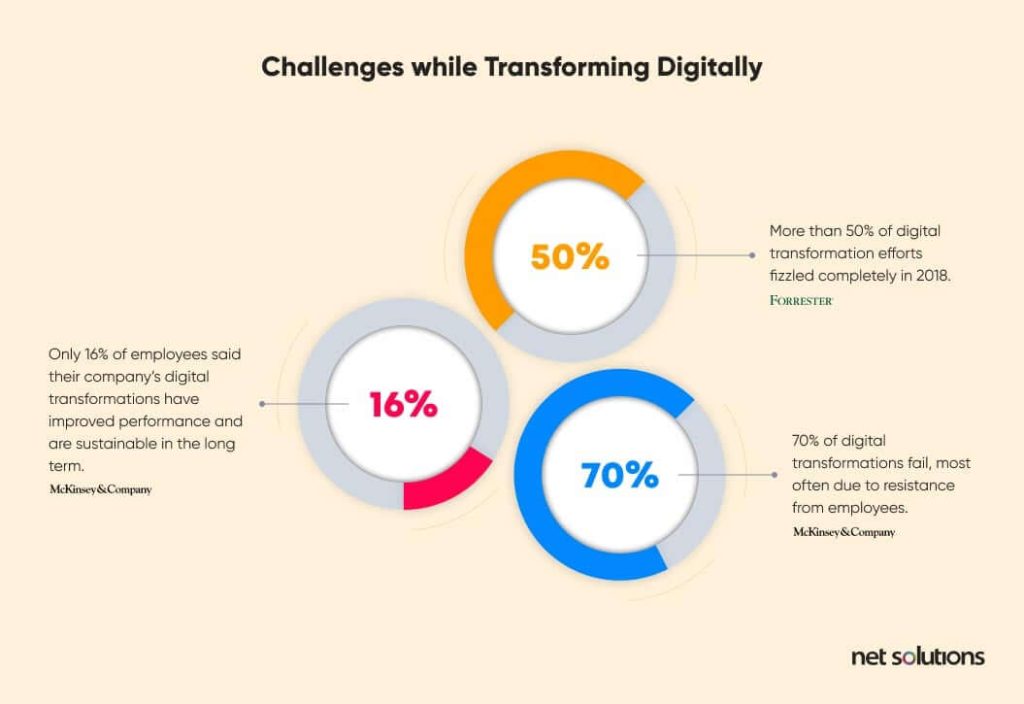
Digital Transformation Risks and Challenges
In today’s digital world, customers have become accustomed to more efficient and immediate solutions because technology infiltrates each part of their daily lives. For this reason, they have come to expect more from the organizations they do business with, wanting the same experience from these companies as they would with digital solutions elsewhere. Thus, companies have started upgrading their digital transformation programs to meet consumers’ and staff’s needs. This basically entails integrating digital technology into different aspects of the business to improve operations.
Furthermore, Forbes explains in an article that 70% of companies already have complex digital transformation strategies or are working on one. Seeing this statistic gives an excellent indication of the enormous scale on which this transformation is taking place.
However, moving with the times and implementing new digital solutions don’t come without risks and challenges. Preparing for these potential pitfalls could assist a company in completing its digital transformation successfully. With this in mind, below is more helpful information as well as tips on managing digital transformation difficulties:
Risks Associated with Digital Transformation
When defining risk, cyber security consulting services could explain it to be anything digital that may potentially cause harm or danger to the company. When digital transformation services and solutions aren’t secure, companies may face legal ramifications, loss of trust from their customers, and ultimately loss of revenue. That said, here are some of the risks involved when companies take on digital transformation:
- Data breaches
- There are many reasons for a data breach. Even so, most result in data falling into the wrong hands and causing harm to the company or its clients. One example that may lead to a data breach is companies using outdated software solutions that cannot integrate with newer technology or security measures.
- Cyber-attacks
- Cyber-security is a major digital strategy risk management. Cybercriminals could employ various strategies to get the company data to use with malicious intent. As per Statista says some examples may include phishing, identity fraud, and ransomware, among other infringements. Hence, companies that refuse to embrace digital transformation could expose themselves to cyber-attacks by not having the latest in cyber security.
- Loss of sensitive information
- Trade secrets, customer or staff information, and other sensitive data form part of daily operations for any company. The thought of any of it becoming public could be enough to drive businesses to transform their digital transformation procedures to include more stringent measures for keeping it safe.
- Unfortunately, not all of the workforce’s digital skills will match the new level of technology, so companies may also have to update their workers’ knowledge where needed to prevent future data breaches, cyber-attacks, or loss of sensitive information.

Most Common Digital Transformation Challenges
Despite the possibility of a challenge becoming a risk, it may only pose a hurdle to overcome instead of causing serious harm. Disputes could arise between management, staff, or clients during digital transformation. However, navigating them through a digital strategy risk management plan with the necessary caution could see the company through its technological metamorphosis. Read more here about some of the potential challenges a company could face:
- Lack of expertise
- General workers like administrative staff or financial clerks may require basic training on the new systems, yet implementing and maintaining the latest digital solutions may require more expertise. Regrettably, many companies don’t have a dedicated team like an IT consultant to assist them with the digital transformation risks, which could be challenging in the long run when it slows the company’s progress.
- Resistance to change
- Holding onto antiquated business methods and resisting change may cost the business millions in revenue when it doesn’t include more current digital solutions for its staff and clients. Moreover, board members or management won’t always see eye to eye on the type of transformation the business needs and could then further delay any improvements.
- Budget constraints
- Digital solutions could be a costly venture. Nevertheless, it’s a much-needed expense for businesses looking to further their digital transformation. Challenging as it may seem, companies could consider setting up a budget to complete their digital transformation and manage business transformation risks in various phases instead of replacing all their systems simultaneously.
- Furthermore, prioritizing the areas that need digital transformation most could help create and implement a plan and budget acceptable to everyone involved while addressing the company’s needs.
Managing and Mitigating Digital Transformation Risks
Risks and challenges may be unavoidable for a business, even when addressing its digital transformation with the help of experts in the field. The only plausible, workable way to deal with these would be to anticipate, manage, and mitigate its part in the process by using one or more of the tips below:
- Implementing security protocols
- Digital specialists could assist the company in setting up and implementing a security protocol beneficial to all parties involved. It may include the training of employees mentioned earlier and the promotion of collaboration between departments to abide by the rules and regulations of the protocol.
- Conducting regular risk assessments
- When management aligns the digital transformation solutions with the values and goals of the enterprise by regularly assessing the industry-specific risks, it can focus more on the sectors posing the biggest threat to its systems and thus manage the challenge of digital transformation. As these risks could change over time, frequent follow-ups could confirm whether a digital solution is adequate.
- Set up a growth strategy
- Businesses should remember that digital transformation may take some time to show improvements in their bottom line. Anticipating a gradual increase in efficiency and profit and a solid growth strategy could keep companies on track with their expectations of the changes. Including input from customers and staff regarding the solutions they’d like to see may put the company on the right path to adding digital applications to boost its growth.
Conclusion
Digital transformation may come with a different outlook for each company, and understanding that no two businesses have the exact same challenges maybe half the war won. On the other hand, Finances Online warns that around 70% of companies fail to reach their goals when they don’t manage the changes well.
Moving into the future holds many benefits for a company, including improved efficiency and a more considerable turnover. However, potential pitfalls may hinder its growth and progress.
Understanding, anticipating, and planning for risks and challenges could improve the transition from older systems to the new and lead to a successful digital transformation journey. Managing and mitigating these with equal enthusiasm should ensure a smooth digital transformation for the entire company.




